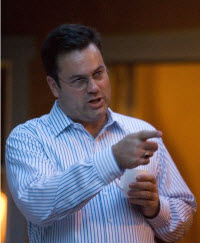Over the years, I've used a number of different assessment tests on
myself and our team. It's a great way to help people better understand
a each other and the different forms of communication and problem solving styles we use.
Here are several of the tests that have proven themselves time and again:
- Kolbe: measures a person's instinctive method of operation, and identifies the ways they will be most productive.
- Myers-Briggs: identifies personality styles and temperaments.
- StrengthsFinder: helps people uncover their talents, so they can do more of those things each day.
 Recently Janine de Nysschen from whytelligence introduced me to a new tool. She helps people perform better by getting them to understand the "Why" and "How" patterns driving them. Janine believes every person has a core sense of purpose that drives their beliefs and behavior, and a logic pattern that is hard-wired into how they think and decide.
Recently Janine de Nysschen from whytelligence introduced me to a new tool. She helps people perform better by getting them to understand the "Why" and "How" patterns driving them. Janine believes every person has a core sense of purpose that drives their beliefs and behavior, and a logic pattern that is hard-wired into how they think and decide.
The whytelligence process helps people discover their distinct purpose, and shows them how embracing and leveraging that can help them thrive and succeed with less effort or resistance.
What Can You Learn from whytelligence?
Janine's starting point was clarifying "Why" I do things. She
identified that I like to help people see what's real (though often hidden), and then show
them how that truth about themselves or what they are doing can help
them. During her next step in the process, here is how she described my "How" pattern:
- First, you confront positions. You listen, you observe, but then you question and you challenge.
- Second, you re-frame the thinking. Most of the time, you do this using stories or metaphors; but sometimes you use practical experiences too.
- Third, you reveal the new paradigm. You get people to re-state their positions in light of what you have helped them understand.
- Fourth, you help people put it into practice. You find opportunities or tell them about options for them to use their new paradigms, knowledge, and experience.
- Finally, you measure response. You will try the applied intelligence, the new technique, or better way – but they have to produce a certain level of value and give you the sense of peace, fulfillment, success, etc. … or it's back to the drawing board.
If you know me, then you probably recognize that pattern. After she pointed it out to me, I recognize that I use it often in my business and personal dealings. It is how I argue, and how I help people. As a coaching point, Janine points out that my first step often is to confront; and that by becoming aware of it, I can soften its delivery for greater impact.
This How pattern also defines my work. In many respects, my job is to decode the logic moving the markets, and to translate that into easy to follow trading systems. This makes sense and is a great fit given my Why and How patterns.
However, Janine then asked if I ever get so focused on finding the right tool or technique to get to a better solution, that I sometimes I forget to look for an endpoint? If you know me, then you probably recognize that pattern too.
Awareness Is the First Step of the Next Step.
In other words, the How pattern can become such a powerful habit, that sometimes it runs by itself. That's interesting information to know. Consequently, recognizing that it is running is important … as are the questions: 'Does it need improvement?' and 'Would breaking-out of it serve you better'?
And in keeping with my pattern,
it made me think a little bit deeper. In a sense, knowing about your pattern shows you how and why you get what you tend to get.
However, if you want to get different results, then you need to change, or perhaps transcend, your habitual patterns in a way that lets you get better results.
Knowing your Why and How patterns can be a great first step towards making those changes happen.
For More Info:
- Here is a link to another article about whytelligence called "Discover the How to Your Why".

